fuel cap FIAT 500L LIVING 2017 2.G Owners Manual
[x] Cancel search | Manufacturer: FIAT, Model Year: 2017, Model line: 500L LIVING, Model: FIAT 500L LIVING 2017 2.GPages: 240, PDF Size: 5.26 MB
Page 36 of 240
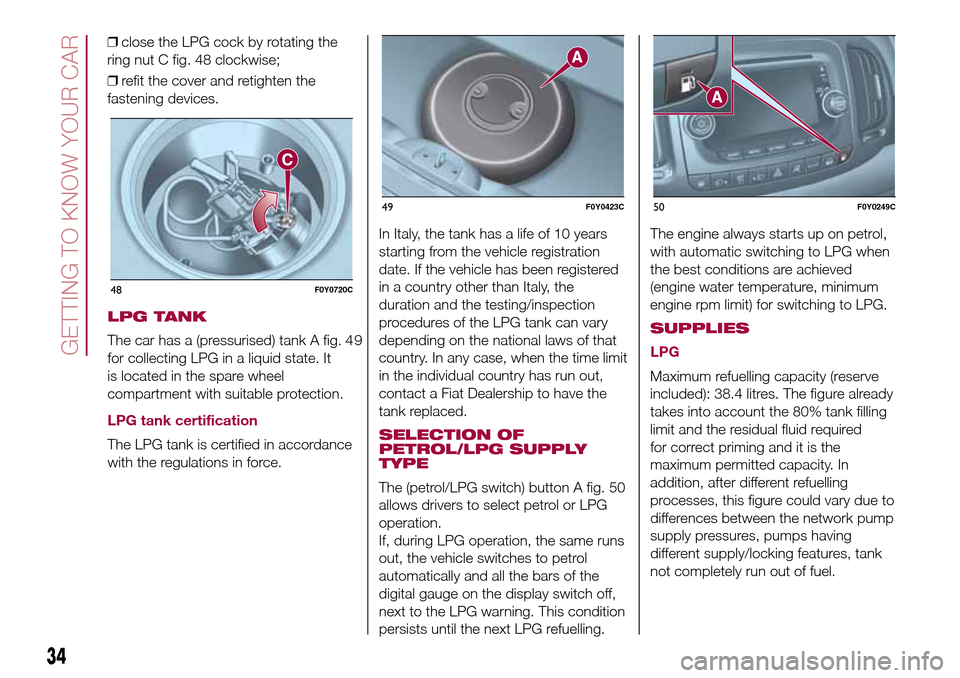
LPG TANK
The car has a (pressurised) tank A fig. 4 9
for collecting LPG in a liquid state. It
is located in the spare wheel
compartment with suitable protection.
LPG tank certification
The LPG tank is certified in accordance
with the regulations in force.In Italy, the tank has a life of 10 years
starting from the vehicle registration
date. If the vehicle has been registered
in a country other than Italy, the
duration and the testing/inspection
procedures of the LPG tank can vary
depending on the national laws of that
country. In any case, when the time limit
in the individual country has run out,
contact a Fiat Dealership to have the
tank replaced.SELECTION OF
PETROL/LPG SUPPLY
TYPE
The (petrol/LPG switch) button A fig. 50
allows drivers to select petrol or LPG
operation.
If, during LPG operation, the same runs
out, the vehicle switches to petrol
automatically and all the bars of the
digital gauge on the display switch off,
next to the LPG warning. This condition
persists until the next LPG refuelling.The engine always starts up on petrol,
with automatic switching to LPG when
the best conditions are achieved
(engine water temperature, minimum
engine rpm limit) for switching to LPG.
SUPPLIES
LPG
Maximum refuelling capacity (reserve
included): 38.4 litres. The figure already
takes into account the 80% tank filling
limit and the residual fluid required
for correct priming and it is the
maximum permitted capacity. In
addition, after different refuelling
processes, this figure could vary due to
differences between the network pump
supply pressures, pumps having
different supply/locking features, tank
not completely run out of fuel.
48F0Y0720C
49F0Y0423C50F0Y0249C
34
GETTING TO KNOW YOUR CAR
❒close the LPG cock by rotating the
ring nut C fig. 48 clockwise;
❒refit the cover and retighten the
fastening devices.
Page 37 of 240

IMPORTANT In order to avoid
inconsistent information by the LPG
gauge on the instrument panel, it is
recommended to refill with at least 10
litres each time.
WARNING
35)Please note that in some countries
(including Italy) there are legal restrictions
in force for parking/garaging motor
vehicles with gas that has a higher density
than air; LPG comes under this category.
36)Do not switch between the two
operating modes whilst starting the engine.
37)If gas is smelled, switch from methane
operation to petrol operation and
immediately go to a Fiat Dealership to have
the vehicle checked and possible system
faults excluded.
WARNING
16)The vehicle is equipped with a gaseous
LPG injection system designed specifically
for it: it is therefore absolutely forbidden
to alter the configuration of the system or
its components. The use of other
components or materials could cause
malfunctions and lead to a reduction
in safety; therefore, in the case of
problems, contact a Fiat Dealership. When
towing or lifting the car, follow the
instructions in the paragraph on "Towing
the car" to prevent damage to the gas
methane system parts.17)The system operates at temperatures
ranging between −20 °C and 100 °C.
18)When painting in an oven, the LPG
tank must be removed from the vehicle and
later refitted by a Fiat Dealership. Although
the LPG system has numerous safety
features, it is advisable to proceed
as follows every time the car is not in use
for a long period or moved in an
emergency as a result of a breakdown or
accident: unscrew the fastening devices of
the LPG tank, then remove it. Close the
LPG cock rotating the ring nut C clockwise
(see "Passive/active Safety"). Refit the
cover and retighten the fastening devices.
19)Only use LPG fuel for motor vehicles.
20)It is strictly forbidden to use any
additive in the LPG. Periodically (at least
once every six months) it is advisable to let
the LPG in the tank run out and, at the
first refuelling, to check that it does not
exceed the maximum capacity of 38.4 litres
(reserve included) (with a tolerance of 2
litres excess). If the level is above 38.4 litres
(reserve included) contact a Fiat
Dealership immediately.
21)When switching from petrol to methane
is requested, a metal noise is heard from
the valves which pressurise the circuit. As a
result of the switching logic described
above, the delay between the ticking of the
valve and the switching off of the warning
on the instrument panel is entirely normal.22)In particular usage conditions, such as
starting and operation at low ambient
temperature or supply of LPG with low
content of propane, the system may
temporarily switch to petrol operation,
without indicating the performed switching
on the instrument panel. In the event of
low LPG levels in the tank or request for
high performance (e.g. overtaking, car fully
laden, steep hills) the system may
automatically switch to petrol operation to
guarantee the engine power requested; the
green warning light on the instrument
panel switches on to indicate this. When
the above conditions are no longer
present, the system automatically restores
LPG operation; the green warning light
switches off. To achieve the above
automatic switching, make sure that there
is enough fuel in the petrol tank.
35
Page 38 of 240
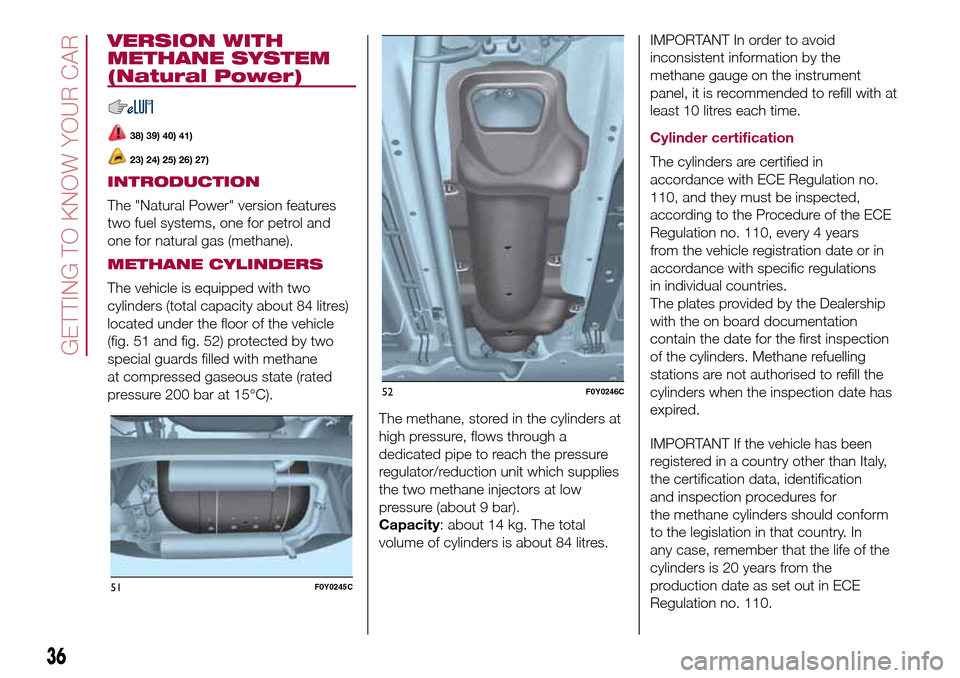
VERSION WITH
METHANE SYSTEM
(Natural Power)
38) 39) 40) 41)
23) 24) 25) 26) 27)
INTRODUCTION
The "Natural Power" version features
two fuel systems, one for petrol and
one for natural gas (methane).
METHANE CYLINDERS
The vehicle is equipped with two
cylinders (total capacity about 84 litres)
located under the floor of the vehicle
(fig. 51 and fig. 52) protected by two
special guards filled with methane
at compressed gaseous state (rated
pressure 200 bar at 15°C).
The methane, stored in the cylinders at
high pressure, flows through a
dedicated pipe to reach the pressure
regulator/reduction unit which supplies
the two methane injectors at low
pressure (about 9 bar).
Capacity: about 14 kg. The total
volume of cylinders is about 84 litres.IMPORTANT In order to avoid
inconsistent information by the
methane gauge on the instrument
panel, it is recommended to refill with at
least 10 litres each time.
Cylinder certification
The cylinders are certified in
accordance with ECE Regulation no.
110, and they must be inspected,
according to the Procedure of the ECE
Regulation no. 110, every 4 years
from the vehicle registration date or in
accordance with specific regulations
in individual countries.
The plates provided by the Dealership
with the on board documentation
contain the date for the first inspection
of the cylinders. Methane refuelling
stations are not authorised to refill the
cylinders when the inspection date has
expired.
IMPORTANT If the vehicle has been
registered in a country other than Italy,
the certification data, identification
and inspection procedures for
the methane cylinders should conform
to the legislation in that country. In
any case, remember that the life of the
cylinders is 20 years from the
production date as set out in ECE
Regulation no. 110.
51F0Y0245C
52F0Y0246C
36
GETTING TO KNOW YOUR CAR
Page 57 of 240
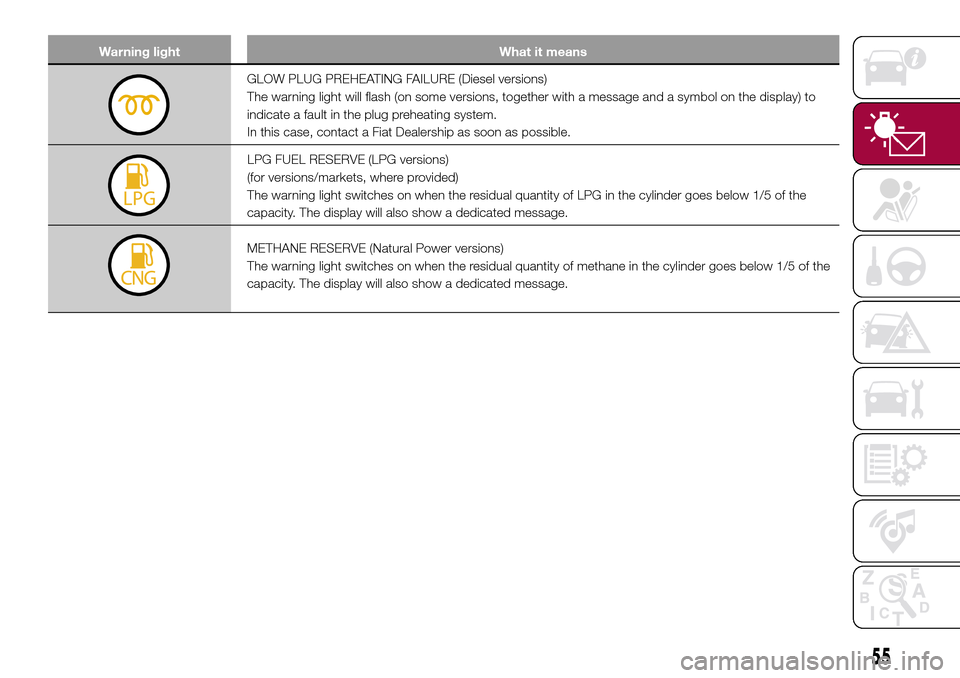
Warning light What it means
GLOW PLUG PREHEATING FAILURE (Diesel versions)
The warning light will flash (on some versions, together with a message and a symbol on the display) to
indicate a fault in the plug preheating system.
In this case, contact a Fiat Dealership as soon as possible.
LPG FUEL RESERVE (LPG versions)
(for versions/markets, where provided)
The warning light switches on when the residual quantity of LPG in the cylinder goes below 1/5 of the
capacity. The display will also show a dedicated message.
METHANE RESERVE (Natural Power versions)
The warning light switches on when the residual quantity of methane in the cylinder goes below 1/5 of the
capacity. The display will also show a dedicated message.
55
Page 73 of 240
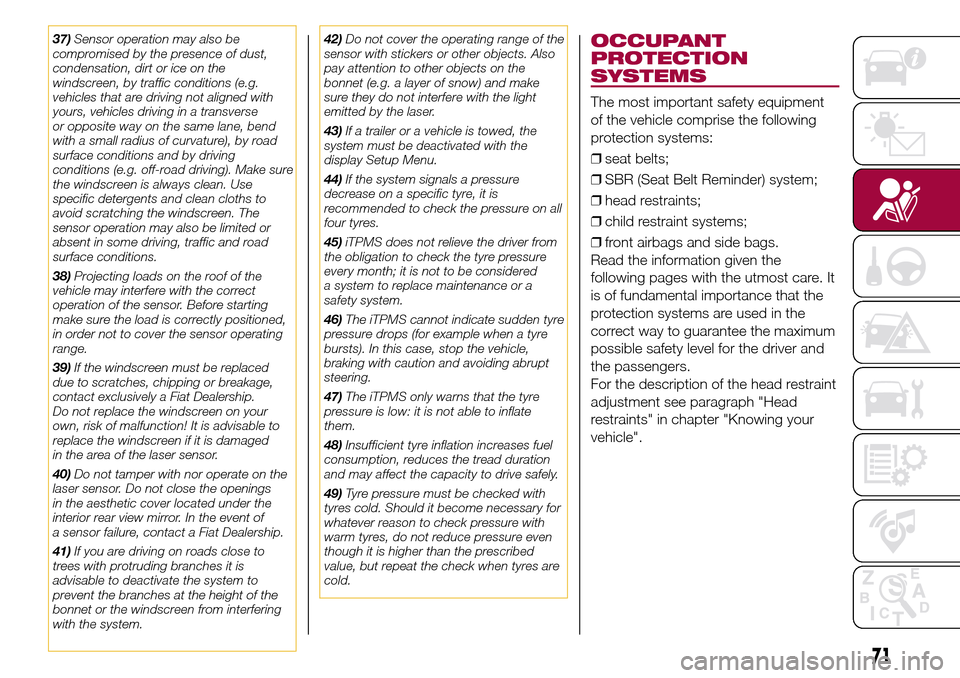
37)Sensor operation may also be
compromised by the presence of dust,
condensation, dirt or ice on the
windscreen, by traffic conditions (e.g.
vehicles that are driving not aligned with
yours, vehicles driving in a transverse
or opposite way on the same lane, bend
with a small radius of curvature), by road
surface conditions and by driving
conditions (e.g. off-road driving). Make sure
the windscreen is always clean. Use
specific detergents and clean cloths to
avoid scratching the windscreen. The
sensor operation may also be limited or
absent in some driving, traffic and road
surface conditions.
38)Projecting loads on the roof of the
vehicle may interfere with the correct
operation of the sensor. Before starting
make sure the load is correctly positioned,
in order not to cover the sensor operating
range.
39)If the windscreen must be replaced
due to scratches, chipping or breakage,
contact exclusively a Fiat Dealership.
Do not replace the windscreen on your
own, risk of malfunction! It is advisable to
replace the windscreen if it is damaged
in the area of the laser sensor.
40)Do not tamper with nor operate on the
laser sensor. Do not close the openings
in the aesthetic cover located under the
interior rear view mirror. In the event of
a sensor failure, contact a Fiat Dealership.
41)If you are driving on roads close to
trees with protruding branches it is
advisable to deactivate the system to
prevent the branches at the height of the
bonnet or the windscreen from interfering
with the system.42)Do not cover the operating range of the
sensor with stickers or other objects. Also
pay attention to other objects on the
bonnet (e.g. a layer of snow) and make
sure they do not interfere with the light
emitted by the laser.
43)If a trailer or a vehicle is towed, the
system must be deactivated with the
display Setup Menu.
44)If the system signals a pressure
decrease on a specific tyre, it is
recommended to check the pressure on all
four tyres.
45)iTPMS does not relieve the driver from
the obligation to check the tyre pressure
every month; it is not to be considered
a system to replace maintenance or a
safety system.
46)The iTPMS cannot indicate sudden tyre
pressure drops (for example when a tyre
bursts). In this case, stop the vehicle,
braking with caution and avoiding abrupt
steering.
47)The iTPMS only warns that the tyre
pressure is low: it is not able to inflate
them.
48)Insufficient tyre inflation increases fuel
consumption, reduces the tread duration
and may affect the capacity to drive safely.
49)Tyre pressure must be checked with
tyres cold. Should it become necessary for
whatever reason to check pressure with
warm tyres, do not reduce pressure even
though it is higher than the prescribed
value, but repeat the check when tyres are
cold.OCCUPANT
PROTECTION
SYSTEMS
The most important safety equipment
of the vehicle comprise the following
protection systems:
❒seat belts;
❒SBR (Seat Belt Reminder) system;
❒head restraints;
❒child restraint systems;
❒front airbags and side bags.
Read the information given the
following pages with the utmost care. It
is of fundamental importance that the
protection systems are used in the
correct way to guarantee the maximum
possible safety level for the driver and
the passengers.
For the description of the head restraint
adjustment see paragraph "Head
restraints" in chapter "Knowing your
vehicle".
71
Page 108 of 240
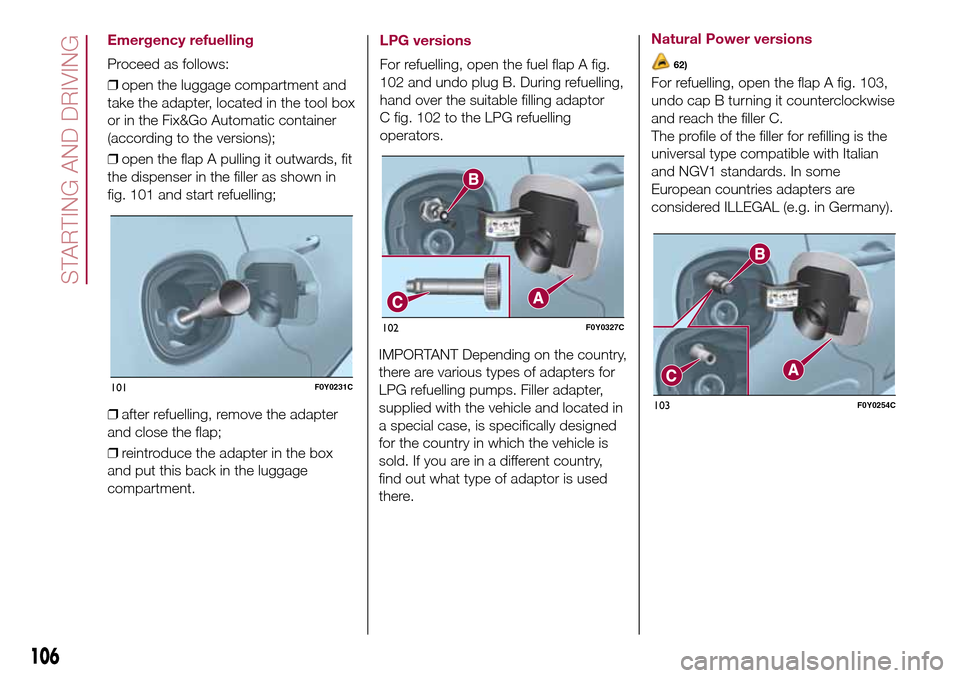
Emergency refuelling
Proceed as follows:
❒open the luggage compartment and
take the adapter, located in the tool box
or in the Fix&Go Automatic container
(according to the versions);
❒open the flap A pulling it outwards, fit
the dispenser in the filler as shown in
fig. 101 and start refuelling;
❒after refuelling, remove the adapter
and close the flap;
❒reintroduce the adapter in the box
and put this back in the luggage
compartment.
LPG versions
For refuelling, open the fuel flap A fig.
102 and undo plug B. During refuelling,
hand over the suitable filling adaptor
C fig. 102 to the LPG refuelling
operators.
IMPORTANT Depending on the country,
there are various types of adapters for
LPG refuelling pumps. Filler adapter,
supplied with the vehicle and located in
a special case, is specifically designed
for the country in which the vehicle is
sold. If you are in a different country,
find out what type of adaptor is used
there.
Natural Power versions
62)
For refuelling, open the flap A fig. 103,
undo cap B turning it counterclockwise
and reach the filler C.
The profile of the filler for refilling is the
universal type compatible with Italian
and NGV1 standards. In some
European countries adapters are
considered ILLEGAL (e.g. in Germany).
101F0Y0231C
102F0Y0327C
103F0Y0254C
106
STARTING AND DRIVING
Page 115 of 240
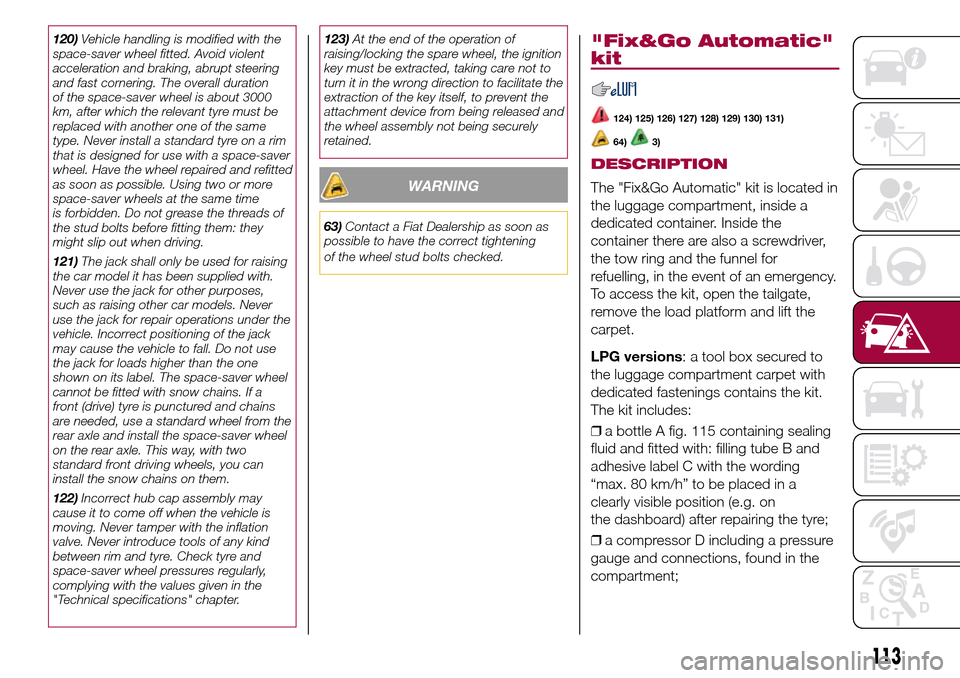
120)Vehicle handling is modified with the
space-saver wheel fitted. Avoid violent
acceleration and braking, abrupt steering
and fast cornering. The overall duration
of the space-saver wheel is about 3000
km, after which the relevant tyre must be
replaced with another one of the same
type. Never install a standard tyre on a rim
that is designed for use with a space-saver
wheel. Have the wheel repaired and refitted
as soon as possible. Using two or more
space-saver wheels at the same time
is forbidden. Do not grease the threads of
the stud bolts before fitting them: they
might slip out when driving.
121)The jack shall only be used for raising
the car model it has been supplied with.
Never use the jack for other purposes,
such as raising other car models. Never
use the jack for repair operations under the
vehicle. Incorrect positioning of the jack
may cause the vehicle to fall. Do not use
the jack for loads higher than the one
shown on its label. The space-saver wheel
cannot be fitted with snow chains. If a
front (drive) tyre is punctured and chains
are needed, use a standard wheel from the
rear axle and install the space-saver wheel
on the rear axle. This way, with two
standard front driving wheels, you can
install the snow chains on them.
122)Incorrect hub cap assembly may
cause it to come off when the vehicle is
moving. Never tamper with the inflation
valve. Never introduce tools of any kind
between rim and tyre. Check tyre and
space-saver wheel pressures regularly,
complying with the values given in the
"Technical specifications" chapter.123)At the end of the operation of
raising/locking the spare wheel, the ignition
key must be extracted, taking care not to
turn it in the wrong direction to facilitate the
extraction of the key itself, to prevent the
attachment device from being released and
the wheel assembly not being securely
retained.
WARNING
63)Contact a Fiat Dealership as soon as
possible to have the correct tightening
of the wheel stud bolts checked.
"Fix&Go Automatic"
kit
124) 125) 126) 127) 128) 129) 130) 131)
64)3)
DESCRIPTION
The "Fix&Go Automatic" kit is located in
the luggage compartment, inside a
dedicated container. Inside the
container there are also a screwdriver,
the tow ring and the funnel for
refuelling, in the event of an emergency.
To access the kit, open the tailgate,
remove the load platform and lift the
carpet.
LPG versions: a tool box secured to
the luggage compartment carpet with
dedicated fastenings contains the kit.
The kit includes:
❒a bottle A fig. 115 containing sealing
fluid and fitted with: filling tube B and
adhesive label C with the wording
“max. 80 km/h” to be placed in a
clearly visible position (e.g. on
the dashboard) after repairing the tyre;
❒a compressor D including a pressure
gauge and connections, found in the
compartment;
113
Page 132 of 240
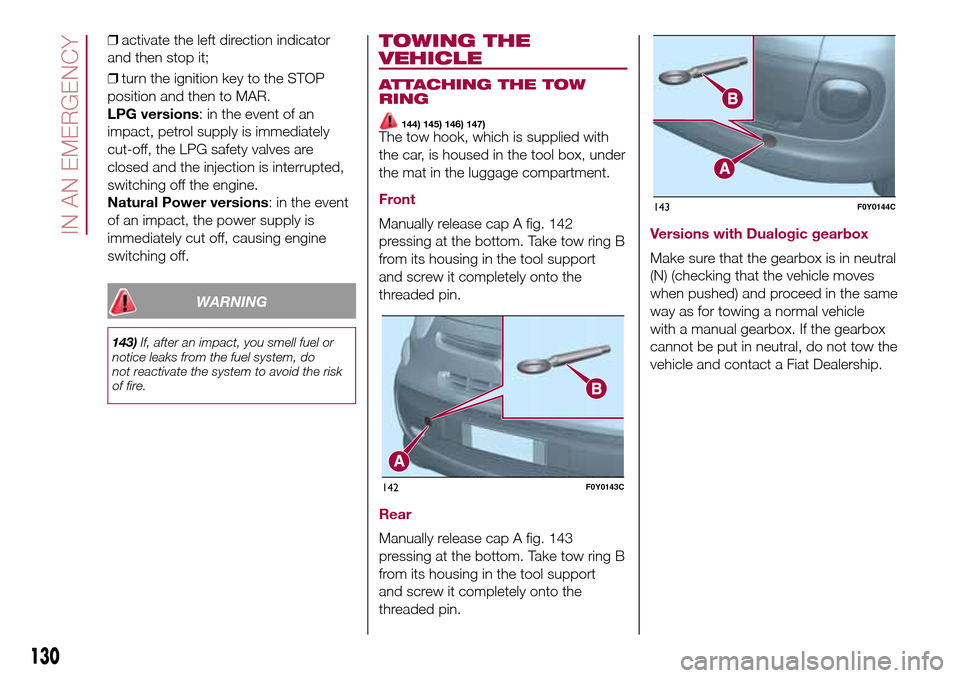
❒activate the left direction indicator
and then stop it;
❒turn the ignition key to the STOP
position and then to MAR.
LPG versions: in the event of an
impact, petrol supply is immediately
cut-off, the LPG safety valves are
closed and the injection is interrupted,
switching off the engine.
Natural Power versions: in the event
of an impact, the power supply is
immediately cut off, causing engine
switching off.
WARNING
143)If, after an impact, you smell fuel or
notice leaks from the fuel system, do
not reactivate the system to avoid the risk
of fire.
TOWING THE
VEHICLE
ATTACHING THE TOW
RING
144) 145) 146) 147)The tow hook, which is supplied with
the car, is housed in the tool box, under
the mat in the luggage compartment.
Front
Manually release cap A fig. 142
pressing at the bottom. Take tow ring B
from its housing in the tool support
and screw it completely onto the
threaded pin.
Rear
Manually release cap A fig. 143
pressing at the bottom. Take tow ring B
from its housing in the tool support
and screw it completely onto the
threaded pin.
Versions with Dualogic gearbox
Make sure that the gearbox is in neutral
(N) (checking that the vehicle moves
when pushed) and proceed in the same
way as for towing a normal vehicle
with a manual gearbox. If the gearbox
cannot be put in neutral, do not tow the
vehicle and contact a Fiat Dealership.
142F0Y0143C
143F0Y0144C
130
IN AN EMERGENCY